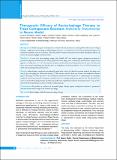Please use this identifier to cite or link to this item:
https://hdl.handle.net/20.500.14356/1051| Title: | Therapeutic Efficacy of Bacteriophage Therapy to Treat Carbapenem Resistant Klebsiella Pneumoniae in Mouse Model |
| Authors: | Dhungana, Gunaraj Regmi, Madhav Paudel, Prashant Parajuli, Apsara Upadhyay, Elisha Gyawali, Indu Upreti, Himani Nepal, Roshan Pradhan, Pragati Malla, Rajani |
| Citation: | DhunganaG., RegmiM., PaudelP., ParajuliA., UpadhyayE., GyawaliI., UpretiH., NepalR., PradhanP., & MallaR. (2021). Therapeutic Efficacy of Bacteriophage Therapy to Treat Carbapenem Resistant Klebsiella Pneumoniae in Mouse Model. Journal of Nepal Health Research Council, 19(1), 76-82. https://doi.org/10.33314/jnhrc.v19i1.3282 |
| Issue Date: | 2021 |
| Publisher: | Nepal Health Research Council |
| Article Type: | Original Article |
| Keywords: | Bacteriophage Klebsiella pneumonia Phage therapy |
| Series/Report no.: | Jan-March, 2021;3282 |
| Abstract: | Abstract Background: Global emergence of carbapenem-resistant Klebsiella pneumoniae is a major public health concern. Phage therapy – application of lytic phage to kill pathogenic bacteria – is considered as one of the promising alternatives to tackle this antibiotic crisis in recent days. This study aimed to isolate, characterize and evaluate therapeutic efficacy of a novel K. pneumoniae phage in mouse model. Methods: A novel lytic bacteriophage (phage) Kp_Pokalde_002 was isolated against carbapenem-resistant K. pneumoniae (Kp56) and characterized. Safety parameters of the phage were evaluated by bioinformatic analysis of its genome. A lethal dose (~1×107 CFU/mouse) of Kp56 was determined and administrated in the mice. The infected mice were treated with phage Kp_Pokalde_002 at a multiplicity of infection (MOI) 1.0 (~1×107 PFU/mouse) via both oral and intraperitoneal (IP) routes. Results: Isolated phage comprised an icosahedral capsid with a short tail. Based on genome analysis, the phage was strictly lytic belonging the Podoviridae family (T7-like viruses) and free from any virulent and antibiotic-resistant genes. The phage was stable up to 60 °C for 30 minutes and effective between pH 4 to 11 (optimum pH 9). The phage exhibited a short latent period (20 minutes) with burst size of 121 phage particles per infected cell. The infected mice were rescued with the phage therapy via both oral and IP route. Significant reduction of bacterial load (3-7 log10 CFU/ml) in the blood and lung was observed in the treatment group. Conclusions: We provide an evidence of successful phage therapy against carbapenem-resistant K. pneumoniae infected mouse model using locally isolated lytic phage. Keywords: Bacteriophage; klebsiella pneumonia; phage therapy |
| Description: | Original Article |
| URI: | http://103.69.126.140:8080/handle/20.500.14356/1051 |
| ISSN: | Print ISSN: 1727-5482; Online ISSN: 1999-6217 |
| Appears in Collections: | Vol. 19 No. 1 (2021): Vol. 19 No. 1 Issue 50 Jan-Mar 2021 |
Files in This Item:
| File | Description | Size | Format | |
|---|---|---|---|---|
| 3282-Manuscript-21553-1-10-20210425.pdf | Fulltext Article. | 952.08 kB | Adobe PDF |  View/Open |
Items in DSpace are protected by copyright, with all rights reserved, unless otherwise indicated.
